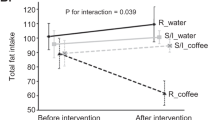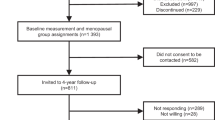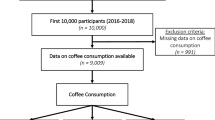Abstract
Background:
A relationship between change in coffee consumption and reduced long-term weight gain has been suggested, but current evidence is inconsistent.
Objective:
To examine longitudinal associations between coffee consumption and changes in body mass index (BMI), fat mass index (FMI), fat-free mass index (FFMI), body fat percentage (BF %) and waist circumference (WC).
Design:
The study consisted of 2128 participants from the Danish part of the MONICA (Monitoring Trends and Determinants in Cardiovascular Disease) cohort with repeated information on coffee consumption, adiposity measures and covariates during an 11-year period. Linear regression analyses were conducted to assess the associations between baseline coffee consumption and subsequent change in adiposity measures. The same analyses were conducted analyzing associations between change in coffee consumption and concurrent as well as subsequent changes in adiposity measures.
Results:
We found no consistent evidence of associations between baseline coffee consumption and subsequent 6-year changes in adiposity measures. A statistically significant association between increased coffee consumption over a 6-year period and decreased concurrent gain in BMI, FMI, BF % and WC (−0.05 kg m−2 (95% confidence interval (CI): −0.07, −0.02), −0.04 kg m−2 (95% CI: −0.06, −0.02), −0.08% (95% CI: −0.13, −0.04) and −0.23 cm (95% CI: −0.34, −0.12), respectively, per 1 cup day−1 increase in coffee consumption) was found. No association was seen between change in coffee consumption and concurrent change in FFMI. Moreover, an initial change in coffee consumption during the first 5-year period was not associated with change in adiposity during the subsequent 6-year period.
Conclusions:
Increased coffee consumption was associated with a decreased concurrent gain in body weight, fat mass and waist circumference, but the associations were weak. Moreover, a causal relationship could not be established, as we found no evidence of associations between an initial change in coffee consumption and subsequent change in adiposity.
This is a preview of subscription content, access via your institution
Access options
Subscribe to this journal
Receive 12 print issues and online access
$259.00 per year
only $21.58 per issue
Buy this article
- Purchase on Springer Link
- Instant access to full article PDF
Prices may be subject to local taxes which are calculated during checkout
Similar content being viewed by others
References
Gunter MJ, Murphy N, Cross AJ, Dossus L, Dartois L, Fagherazzi G et al. Coffee drinking and mortality in 10 european countries: a multinational cohort study. Ann Intern Med 2017; 167: 236–247.
Lopez-Garcia E, van Dam RM, Rajpathak S, Willett WC, Manson JE, Hu FB . Changes in caffeine intake and long-term weight change in men and women. Am J Clin Nutr 2006; 83: 674–680.
van Dam RM, Hu FB . Coffee consumption and risk of type 2 diabetes: a systematic review. JAMA 2005; 294: 97–104.
Wang A, Wang S, Zhu C, Huang H, Wu L, Wan X et al. Coffee and cancer risk: a meta-analysis of prospective observational studies. Sci Rep 2016; 6: 33711.
Grosso G, Godos J, Galvano F, Giovannucci EL . Coffee caffeine, and health outcomes: an umbrella review. Annu Rev Nutr 2017; 37: 131–156.
Nuhu AA . Bioactive micronutrients in coffee: recent analytical approaches for characterization and quantification. ISRN Nutr 2014; 2014: 384230.
Acheson KJ, Zahorska-Markiewicz B, Pittet P, Anantharaman K, Jequier E . Caffeine and coffee: their influence on metabolic rate and substrate utilization in normal weight and obese individuals. Am J Clin Nutr 1980; 33: 989–997.
Bracco D, Ferrarra JM, Arnaud MJ, Jequier E, Schutz Y . Effects of caffeine on energy metabolism, heart rate, and methylxanthine metabolism in lean and obese women. Am J Physiol 1995; 269 (Pt 1): E671–E678.
Dulloo AG, Geissler CA, Horton T, Collins A, Miller DS . Normal caffeine consumption: influence on thermogenesis and daily energy expenditure in lean and postobese human volunteers. Am J Clin Nutr 1989; 49: 44–50.
Jung RT, Shetty PS, James WP, Barrand MA, Callingham BA . Caffeine: its effect on catecholamines and metabolism in lean and obese humans. Clin Sci (Lond) 1981; 60: 527–535.
Yoshida T, Sakane N, Umekawa T, Kondo M . Relationship between basal metabolic rate, thermogenic response to caffeine, and body weight loss following combined low calorie and exercise treatment in obese women. Int J Obes Relat Metab Disord 1994; 18: 345–350.
Harpaz E, Tamir S, Weinstein A, Weinstein Y . The effect of caffeine on energy balance. J Basic Clin Physiol Pharmacol 2017; 28: 1–10.
Jessen A, Buemann B, Toubro S, Skovgaard IM, Astrup A . The appetite-suppressant effect of nicotine is enhanced by caffeine. Diabetes Obes Metab 2005; 7: 327–333.
Carter BE, Drewnowski A . Beverages containing soluble fiber, caffeine, and green tea catechins suppress hunger and lead to less energy consumption at the next meal. Appetite 2012; 59: 755–761.
Greenberg JA, Geliebter A . Coffee hunger, and peptide YY. J Am Coll Nutr 2012; 31: 160–166.
Allison DB, Fontaine KR, Heshka S, Mentore JL, Heymsfield SB . Alternative treatments for weight loss: a critical review. Crit Rev Food Sci Nutr 2001; 41: 1–28.
Greenberg JA, Boozer CN, Geliebter A . Coffee diabetes, and weight control. Am J Clin Nutr 2006; 84: 682–693.
Johnston KL, Clifford MN, Morgan LM . Coffee acutely modifies gastrointestinal hormone secretion and glucose tolerance in humans: glycemic effects of chlorogenic acid and caffeine. Am J Clin Nutr 2003; 78: 728–733.
Nordestgaard AT, Thomsen M, Nordestgaard BG . Coffee intake and risk of obesity, metabolic syndrome and type 2 diabetes: a Mendelian randomization study. Int J Epidemiol 2015; 44: 551–565.
Berkey CS, Rockett HR, Colditz GA . Weight gain in older adolescent females: the internet, sleep, coffee, and alcohol. J Pediatr 2008; 153: 635–639.
Larsen SC, Angquist L, Ahluwalia TS, Skaaby T, Roswall N, Tjonneland A et al. Dietary ascorbic acid and subsequent change in body weight and waist circumference: associations may depend on genetic predisposition to obesity—a prospective study of three independent cohorts. Nutr J 2014; 13: 43.
Larsen SC, Angquist L, Sorensen TI, Heitmann BL . 24 h urinary sodium excretion and subsequent change in weight, waist circumference and body composition. PLoS One 2013; 8: e69689.
Grosso G, Micek A, Godos J, Sciacca S, Pajak A, Martinez-Gonzalez MA et al. Coffee consumption and risk of all-cause, cardiovascular, and cancer mortality in smokers and non-smokers: a dose-response meta-analysis. Eur J Epidemiol 2016; 31: 1191–1205.
Thom E . The effect of chlorogenic acid enriched coffee on glucose absorption in healthy volunteers and its effect on body mass when used long-term in overweight and obese people. J Int Med Res 2007; 35: 900–908.
Onakpoya I, Terry R, Ernst E . The use of green coffee extract as a weight loss supplement: a systematic review and meta-analysis of randomised clinical trials. Gastroenterol Res Pract 2011; 2011: 382852.
Shimoda H, Seki E, Aitani M . Inhibitory effect of green coffee bean extract on fat accumulation and body weight gain in mice. BMC Complement Altern Med 2006; 6: 9.
Cho AS, Jeon SM, Kim MJ, Yeo J, Seo KI, Choi MS et al. Chlorogenic acid exhibits anti-obesity property and improves lipid metabolism in high-fat diet-induced-obese mice. Food Chem Toxicol 2010; 48: 937–943.
Murase T, Misawa K, Minegishi Y, Aoki M, Ominami H, Suzuki Y et al. Coffee polyphenols suppress diet-induced body fat accumulation by downregulating SREBP-1c and related molecules in C57BL/6J mice. Am J Physiol Endocrinol Metab 2011; 300: E122–E133.
Wang T, Huang T, Kang JH, Zheng Y, Jensen MK, Wiggs JL et al. Habitual coffee consumption and genetic predisposition to obesity: gene-diet interaction analyses in three US prospective studies. BMC Med 2017; 15: 97.
Author information
Authors and Affiliations
Corresponding author
Ethics declarations
Competing interests
The authors declare no conflict of interest.
Additional information
Supplementary Information accompanies this paper on International Journal of Obesity website
Supplementary information
Rights and permissions
About this article
Cite this article
Larsen, S., Mikkelsen, ML., Frederiksen, P. et al. Habitual coffee consumption and changes in measures of adiposity: a comprehensive study of longitudinal associations. Int J Obes 42, 880–886 (2018). https://doi.org/10.1038/ijo.2017.310
Received:
Revised:
Accepted:
Published:
Issue Date:
DOI: https://doi.org/10.1038/ijo.2017.310
This article is cited by
-
The association between healthy beverage index and sarcopenia in Iranian older adults: a case-control study
BMC Geriatrics (2024)
-
Change analysis for intermediate disease markers in nutritional epidemiology: a causal inference perspective
BMC Medical Research Methodology (2024)
-
The association between healthy beverage index and sarcopenic obesity among women with overweight and obesity: a cross-sectional study
BMC Endocrine Disorders (2023)
-
Dietary caffeine intake is associated with favorable metabolic profile among apparently healthy overweight and obese individuals
BMC Endocrine Disorders (2023)
-
Associations of Blood Caffeine and Genetically Predicted Coffee Consumption with Anthropometric Measures of Obesity: A Two Sample Mendelian Randomization Study
The Journal of nutrition, health and aging (2022)



